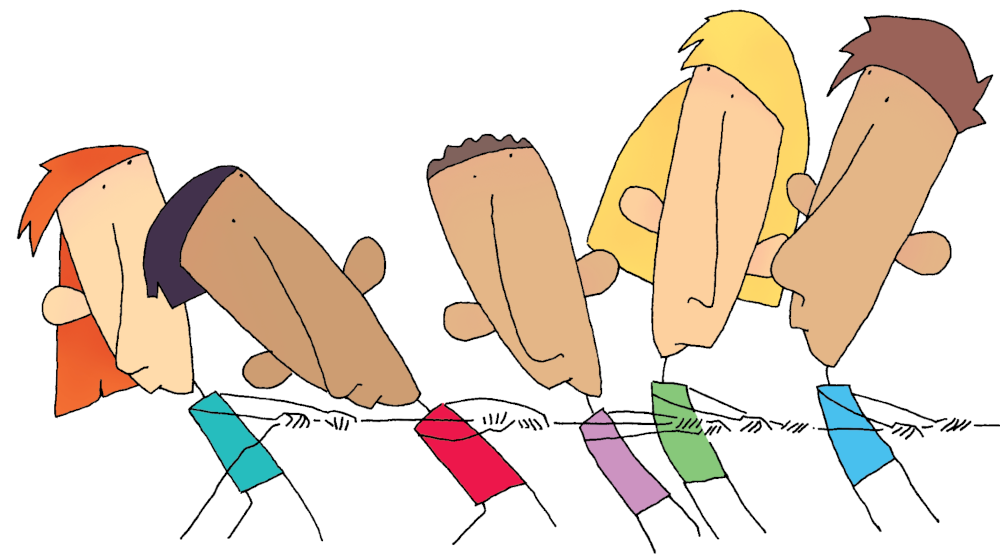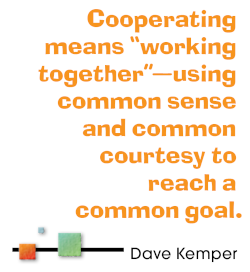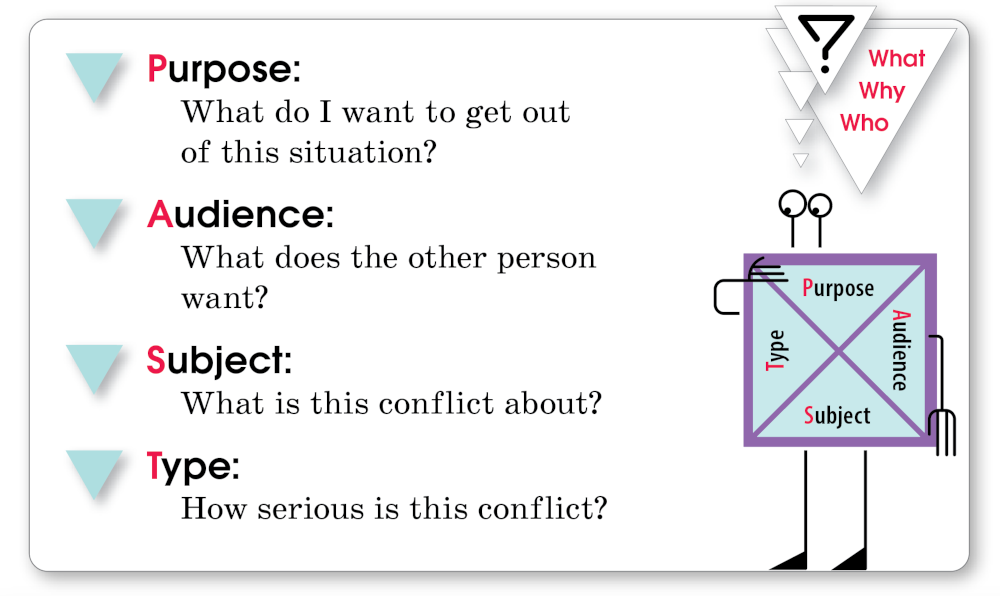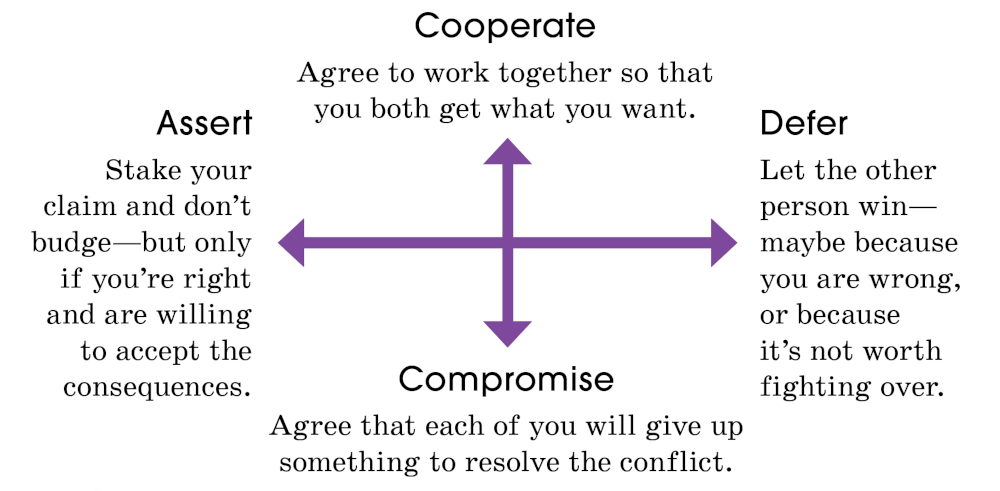WOC 457
Page 457

Using Group Skills
One person tugging on a rope can move something small. Many people pulling together can move something huge. That’s the power of working in a group. If everyone joins forces, the results can be remarkable—like building the Great Pyramid!
On the other hand, if everybody pulls in different directions, the group can’t accomplish anything other than upsetting everyone.
The difference between function and dysfunction comes down to solid group skills. Members must listen, observe, cooperate, clarify, and respond—and resolve conflicts. That’s a lot! But you’ll learn about these skills in the next few pages, and even learn how to collaborate with others online.
“Ready? Set? Pull!”
What’s Ahead
WOC 458
Page 458
Listening
When a computer runs too many programs at once, the app you are using slows and might even crash. Your brain is the same. To really listen, you need to shut down other thoughts and give your full processing speed and memory to what is happening.
■ Listen actively.
Think about what you are hearing. Let the speaker know you are listening. Make eye contact, nod your head, and remain attentive. Jot down key points. Ask a good question or offer a compliment or comment.
■ Listen accurately.
Don’t just “get the gist.” Listen for details: who? what? where? when? why? how? When the speaker stops, check your understanding by summarizing the ideas: “So, you’re saying . . .” If the speaker corrects your summary or adds anything, make a mental note or write it down. Listening for and repeating facts helps you remember what you’ve heard.
■ Know when—and how—to interrupt.
If you are a good listener, sooner or later you will have a comment, a question, or an important fact to add. Even so, interrupting someone who is speaking is not usually a good idea.
But sometimes it is necessary to interrupt a group member who has wandered off the topic. When that happens, you can say, “Okay, that’s good, but I think we should get back to the main point of our discussion.”
■ Learn how to respond when you are interrupted.
When you are interrupted by a group member, you can let the person speak or can say, “Please let me finish,” or “Just a sec.—I have one more thing.” Whatever you do, be courteous.
Helpful Hint
It’s important for all listeners to keep an open mind about the speaker and the topic. Do not judge beforehand whether you are going to like—or not like—what is about to be said.
WOC 459
Page 459
Observing
Being observant is an important group skill. Very often people “say” as much with their actions and tone of voice as with their words.
■ Watch body language.
At times you can “see” what a person is saying or feeling by the facial expressions, hand gestures, and body positions used.
■ Observe tone of voice.
How does the speaker sound? What does voice tell you about the person’s feelings? See if you can connect your feelings, or empathize.
Cooperating

■ Align your goals.
Think of what another person wants and what you want. Figure out a way to connect the two: “You’re concerned about the cost, and I’m concerned about time. The quickest and least expensive option is . . .”
■ Combine your ideas.
Think of a way forward that uses suggestions from multiple group members. Propose a plan combining different ideas.
Clarifying
Clarifying means “making something clear and easy for others to understand.” To clarify something, you may need to add details or rephrase your original explanation.
■ Offer to explain or clarify.
If what you say is long or complex, you can end by summarizing and then asking, “Are there any questions?”
■ Request help or clarification when needed.
If you are unclear on something, ask questions. Test ideas by offering suggestions based on what the speaker said.
WOC 460
Page 460
Responding
When you work in a group, nearly everything you say and do is a response to what someone else has said or done. First, you hear others’ statements or observe their behavior. Second, you take a moment to think about the ways you could respond. Third, you choose your response.
■ Think before responding.
Someone may say something you disagree with: “Taylor Swift makes terrible music.” Before you knew about group skills, you might have responded by saying, “Yeah, well, you’re terrible.” If you respond in this way, you’ve launched a name-calling session instead of a discussion.
Instead, you can choose how you will respond. You can avoid an argument altogether by saying, “We’ll have to agree to disagree on that one.” Or you can look for details by asking, “What about her music is terrible?” Or you can seek clarification by asking, “What do you mean by ‘terrible’?” After trying to answer the questions, the speaker’s opinion might change—or yours might.
■ Learn how to disagree.
Disagree with the idea, not the speaker. Don’t say, “You’re delusional.” Instead, say, “I disagree. I think Taylor Swift is terrific.” You can continue by listing your reasons for disagreeing. Then you can discuss these points with the speaker.
Communicating with Respect
Whenever you work with a group, be respectful and courteous.
- Respect yourself by
- believing that your own thoughts and feelings have value,
- taking responsibility for what you say, and
- accepting that others may disagree with you.
- Respect others by
- encouraging everyone to participate,
- listening openly to what they have to say, and
- using compliments whenever you can.
WOC 461
Page 461
Resolving Conflicts
Whenever you are dealing with people, conflicts may come up. People disagree, and that’s okay. To manage conflicts, think about the situation.

There are four ways to resolve conflict: cooperate, compromise, assert, or defer.

Helpful Hint
You can also compete: Instead of resolving the conflict, both sides decide that they will try it their way and see which way works out. Use this strategy only after the others have failed.
WOC 462
Page 462
Collaborating Online
Classroom blogs, wikis, and social media allow you to collaborate with others online. Follow these tips for online collaboration:
Tips for Online Collaboration
Know the rules. ■ Follow the rules of whatever collaborative space you are visiting. Remember that classroom collaborative spaces are extensions of the classroom, with all the rules that apply.
Be genuine. ■ Don’t use fake names or log-ins. Don’t pretend to be someone you are not. The whole point of online collaboration is to work with others, so you need to be yourself.
Weigh your words. ■ Choose words that represent you well. Since readers cannot see your body language or hear the tone of your voice, your words need to do all the communicating for you.
Act as you would in public. ■ Know that whatever you post will be viewed by many people, so conduct yourself as if many people were watching—because they are.
Show respect. ■ Be polite, encouraging, and complimentary. Avoid put-downs and negativity. Do not alter another person’s posts unless you know that you are supposed to.
Be smart about conflicts. ■ Conflicts happen online just as they happen in face-to-face communication. Use the strategies you learned on page 461 to resolve those conflicts, and involve your teacher or parent if things get out of hand.
Avoid dangers. ■ Don’t give out private information. Don’t bully and don’t tolerate bullying. If you become uncomfortable with what’s happening online, involve your teacher and parent.
Helpful Hint
When you collaborate online, you create a digital projection of your personality. Take special care. People will perceive who you are based on . . .
- the words you use,
- the pictures and videos you post,
- the links you connect to,
- the groups you join, and
- the ideas you express.